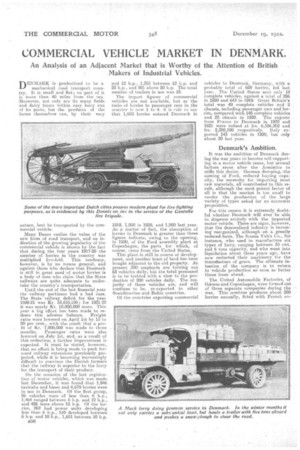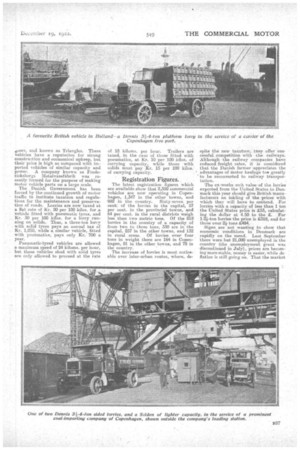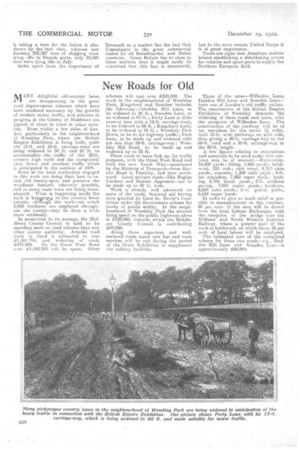COMMERCIAL VEHICLE MARKET IN DENMARK,
Page 22

Page 23

Page 24

If you've noticed an error in this article please click here to report it so we can fix it.
An Analysis of an Adjacent Market that is Worthy of the Attention of British Makers of Industrial Vehicles.
DEI'aEARK is predestined to be a mechanical road transport country. It is small and flat; no part of it is lnore than 40 miles from the sea. Moreover, not only are its many fields and dairy farms within easy lorry run of its ports, but the products of the farms themselves can, by their very
nature, best be transported by the commercial vehicle.
Many Danes realize the value, of the new form of road transport, and an indication of the growing popularity of the commercial vehicle is shown by the fact that during the four years 1917-20 the number of lorries in the country was multiplied five-fold. This tendency, however, is by no means general, and against those who declare that Denmark is still in great need of motor lorries is a body of men who claim that the State railways are quite adequate to undertake the country's transportation.
Until the end of the last financial year the railway partizans had a bad ease. The State railway deficit for the year 1920-21 was Kr. 53,616,190; for 1921-22 it was nearly Kr. 10,000,000 more. This year a big effort has been made to redress this adverse balance.. Freight rates wero. lowered on April 1st by 15 to 20 per cent., with the result that a profit of Kr. 7,000,000 was made in three months. Passenger rates were also lowered on July 1st, and, as a result of this reduction, a further improvement is' expected. It must be stated, however, that no effort is being made to push forward railway extensions previously projected, while it is becoming increasingly difficult to convince the Danish farmers that the railway is superior to the lorry for the transport of their produce.
On the occasion of the last registration of motor vehicles, which was made last December, it was found that 1,946 taxicabs and buses and 4,679 lorries were in use in Denmark. Of the first group, 55 vehicles were of less than 6 h.p., 1,464 ranged between 6 h.p. and 12 h.p., and 426 were above 12 h.p. Of the lorries, 262 had power units developing less than 6 h.p., 510 developed between h.p. and 10 h.p.. 1,651 between 10 h.p.
838
and 12 h.p., 1,355 between 12 h.p. and 20 h.p., and 901 above 20 h.p. The total number of trailers in use was 10.
The import figures of commercial vehicles are not available, but as the ratioof lorries to passenger cars in the country is now 1 to 4. it is safe to say that 1,600 lorries entered Denmark in
1919, 1,000 in 1920, and 1,900 last year. As a matter of fact, the absorption of lorries in Denmark is greater than these figures indicate, owing to the opening; in 1920, of the Ford assembly plant at Copenhagen, the parts for • which, of course, came from the United States.
This plant is still in course of development, and another tract of laud has been bought adjacent to the old property. At present 390. employ Cis are turning out 63 vehicles daily, but the total personnel is to be trebled with a view to the production of 200 vehicles daily. The majority of these vehicles are, and will continue to be, re-exported to other Scandinavian and Baltic countries.
Of the countries exporting commercial
vehicles to Denmark, Germany, with a probable total of 600 lorries, led last year. The United States sent only 18 complete vehicles, against a total of 295 in 1920 and 643 in 1919. Great Britain's total was 49 complete vehicles and 2 chassis, including passenger cars and lorries, compared with 148 complete vehicles and 23 chassis in 1920. The exports from France to Denmark in 1920 and 1921 were valued at frs. 6,586,200 and frs. 2,389,500 respectively. Italy exported 143 vehicles in 1920, but only about 20 last year.
Denmark's Ambition.
It was the ambition of Denmark during the war years to become self-supporting in a motor vehicle sense, but several factors arose after the Armistice to stifle this desire. German dumping, -the coming of Ford, reduced buying capacity, the necessity for importing most raw materials, all contributed to this result, although the most potent factor of all is that the market is too small to render the production of the large variety of types asked for an economic proposition.
For this reason it is extremely doubtful whether Defunark will ever be able to dispense entirely with the imported motor vehicle. There are signs, however, that the demoralized industry is becoming reorganized, although on a greatly reduoad basis. The &Atha Vabis Co., for instance, who used to manufacture six types of lorry, ranging between 30 cwt. and 6 tons capacity, and who went into liquidation about three years ago, have now restarted their machinery for the manufacture of gears. The ultimate intention of the company is to return to vehicle production sosoon as better times loom ahead.
The United Automobile Factories, of Odessa and Copenhagen, were formed out of 'three separate companies during the war. • This combine produces about 200 lorries annually, fitted with French en -Ines and known as Triangles. These vehicles have a reputation for strong construction and economical upkeep, but their price is high as compared with imported vehicles of similar capacity and power. A company known as Frederackshergs Metalvarefribrik was recently formed for the purpose of making motor vehicle parts on a large scale.
The Danish Government has been forced by the continued growth of motor traffic to institute taxation and regulations for the maintenance and preservation of roads. Lorries are now taxed at a flat rate of Kr. 20 per 100 kilos. for .a vehicle fitted with pneumatic tyres, and Kr. 30 per 100 kilos. for a lorry running on solids. Thus, a three-ton lorry with solid tyres pays an annual tax of Kr. 1,050, while a similar vehicle, fitted with pneumatics, pays only Kr. 700 a year.
Pneumatic-tyred vehicles are allowed a maximum speed of 24 kiloms. per hour, but those vehicles shod with solid tyres are only allowed to proceed at the rate
of 18 kiloms. per hour. Trailers are taxed, in the case of those fitted with pneuthatics, at Kr. 10 per 100 kilos. of carrying capacity, while those with solids must pay Kr. 15 per 100 kilos. of carrying capacity. .
Registration Figures.
The latest registration figures which are available show that 2,350 commercial vehicles are now operating in Copenhagen, 1,347 in the other towns, and '982 in the country. Sixty-seven per cent, of the lorries in the capital, 57 per cent, in the provincial towns, and 64 per cent. in the rural districts weigh less than two metric tons. Of the 819 lorries in the country of a capacity of from two to three tons, 330 are in the capital, 257 in the other towns, and 132 in rural areas. Of lorries over four tons in weight there are 164 in Copenhagen, 81 in the other towns, and 78 in the country. .
The increase of lorries is most noticeable over inter-urban routes, where, de spite the new taxation, toey offer. -successful competition with the railways. Although the railway companies have reduced freight rates, it is considered that the Danish farmer :appreciates the advantages .of motor haulage to greatly to be reconverted to railway dansportation.
The ex-works unit value of the lorries exported from the 'United States to Denmark this year should give British manufacturers an inkling of the prices with which they will have to contend. For lorries with a capacity of less than 1 ton the United States price is £53, calculating the dollar at 4.50 to the Z. For 1-2-ton lorries the price is £318, and for those over 2i tons £494.
Signs are not wanting to show that economic -conditions in Denmark are rapidly on the mend. Last September there were but 21,000 unemployed in the country (the unemployment grant was 'discontinued in July), prices are becoming more stable, money is easier, while de. flation is still going on. That the market
is taking a turn for the better is also shown by the fact that, whereas last January 258,267 tons of shipping were lying idle in Danish ports, only 12,595 tons were lying idle in July. Quite apart from the importance of Denmark as a market lies the fact that Copenhagen is the great commercial centre for all Scandinavian and Baltic countries. Great Britain lies so close to these markets that it might easily he conceived that this fact is immaterial, but to the more remote United States it is of great importance.
There are signs that American makers intend establishing a distributing centre for vehicles and spare parts to supply the Northern European field.




























